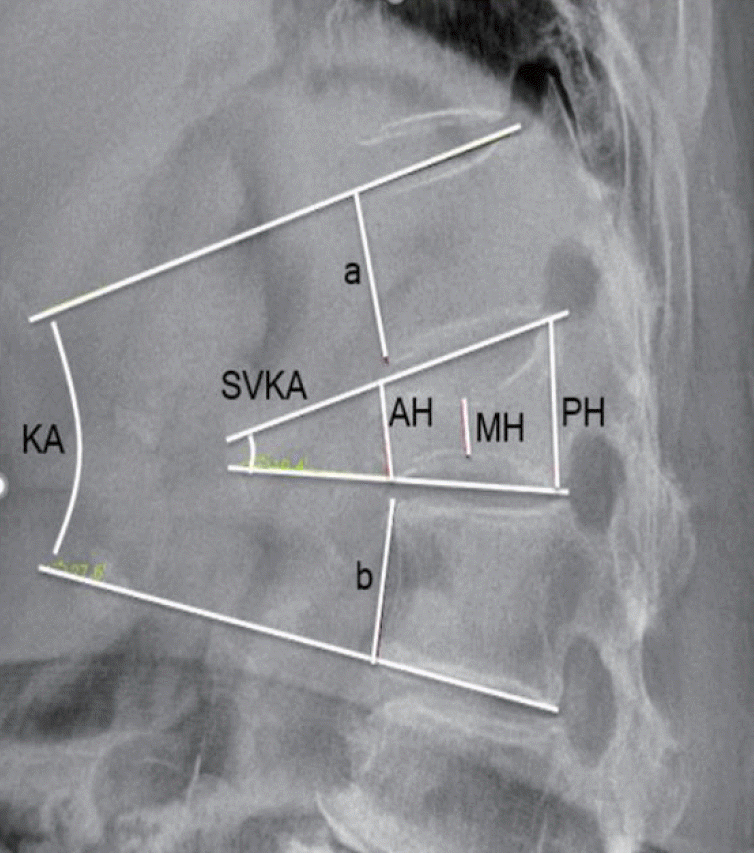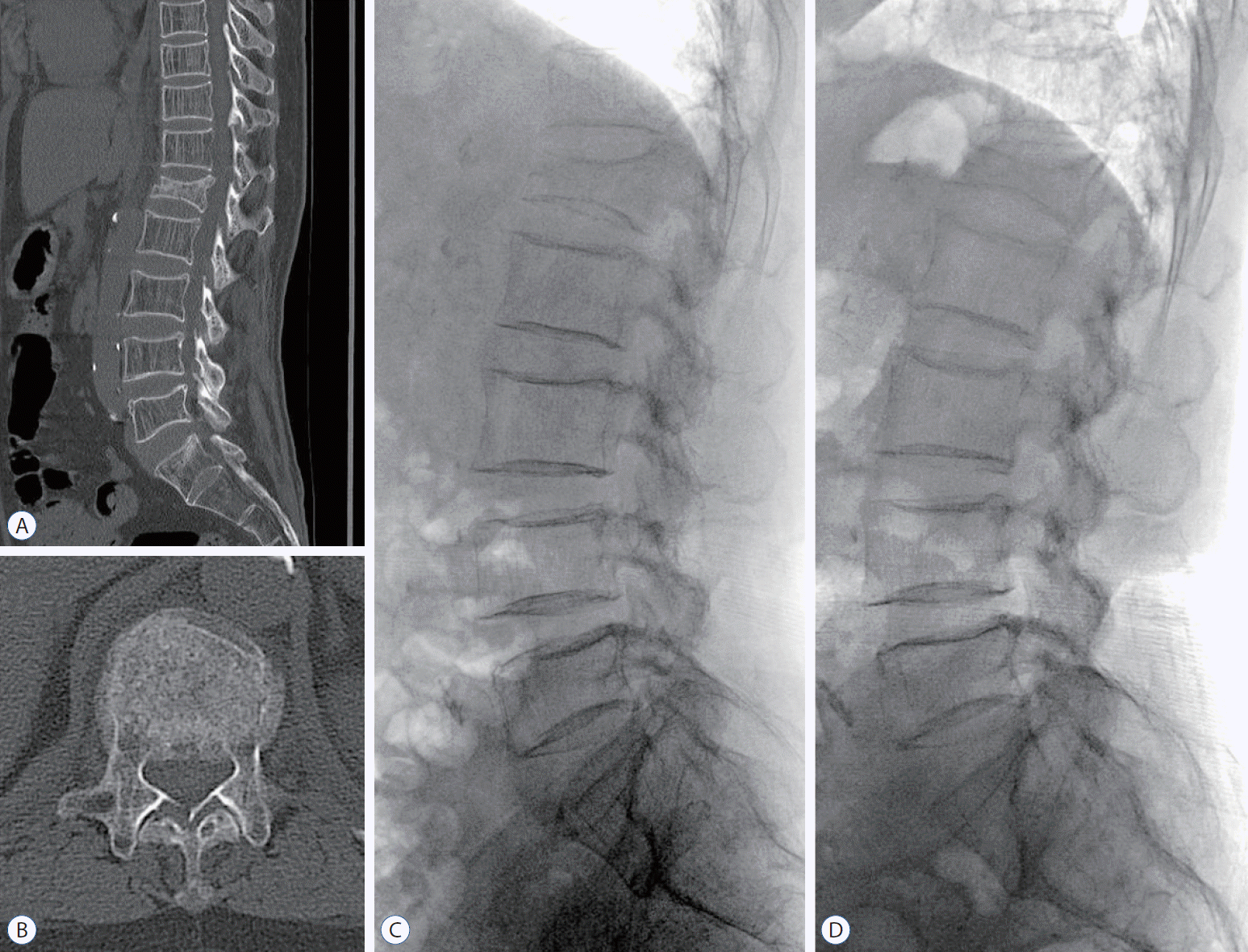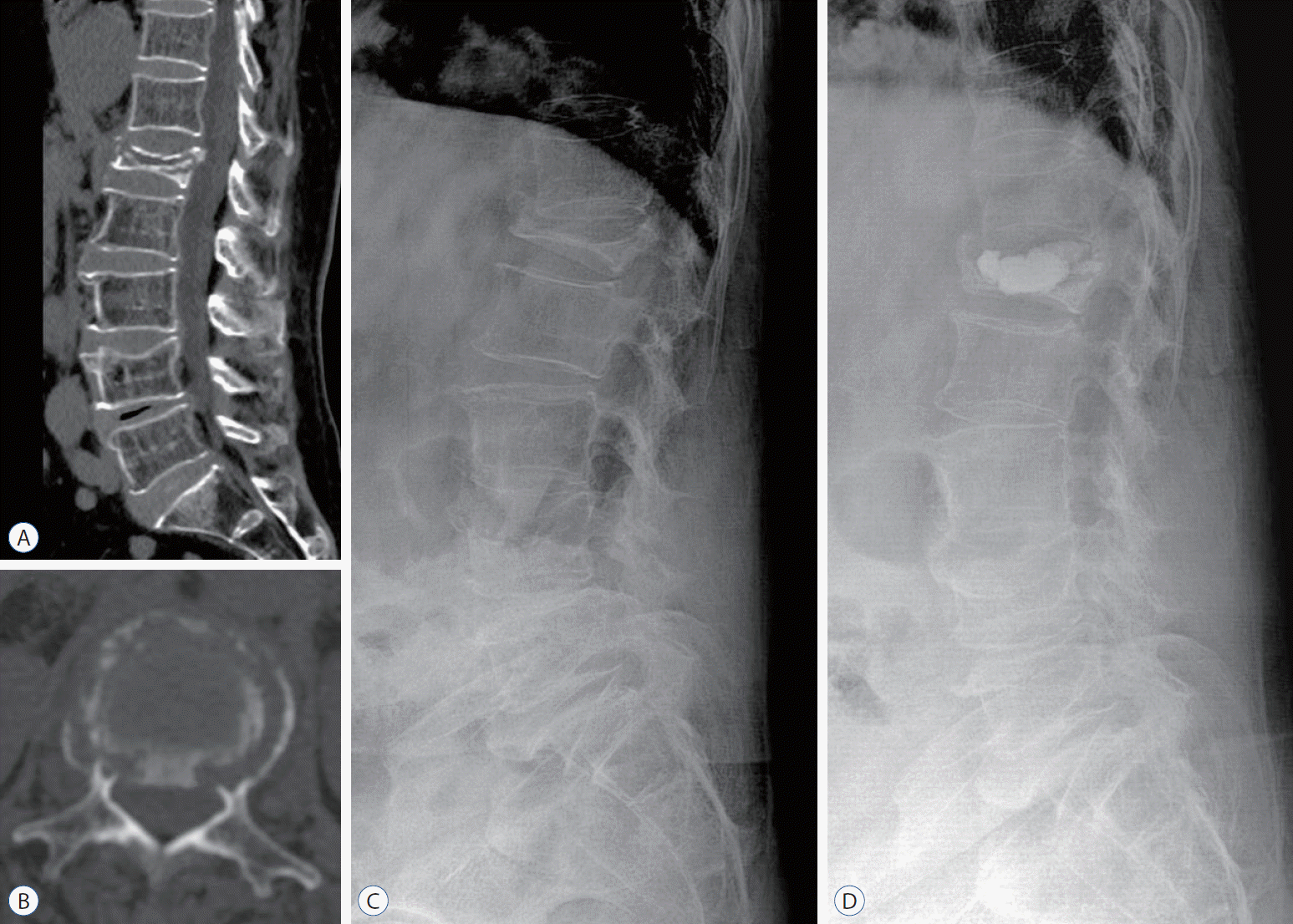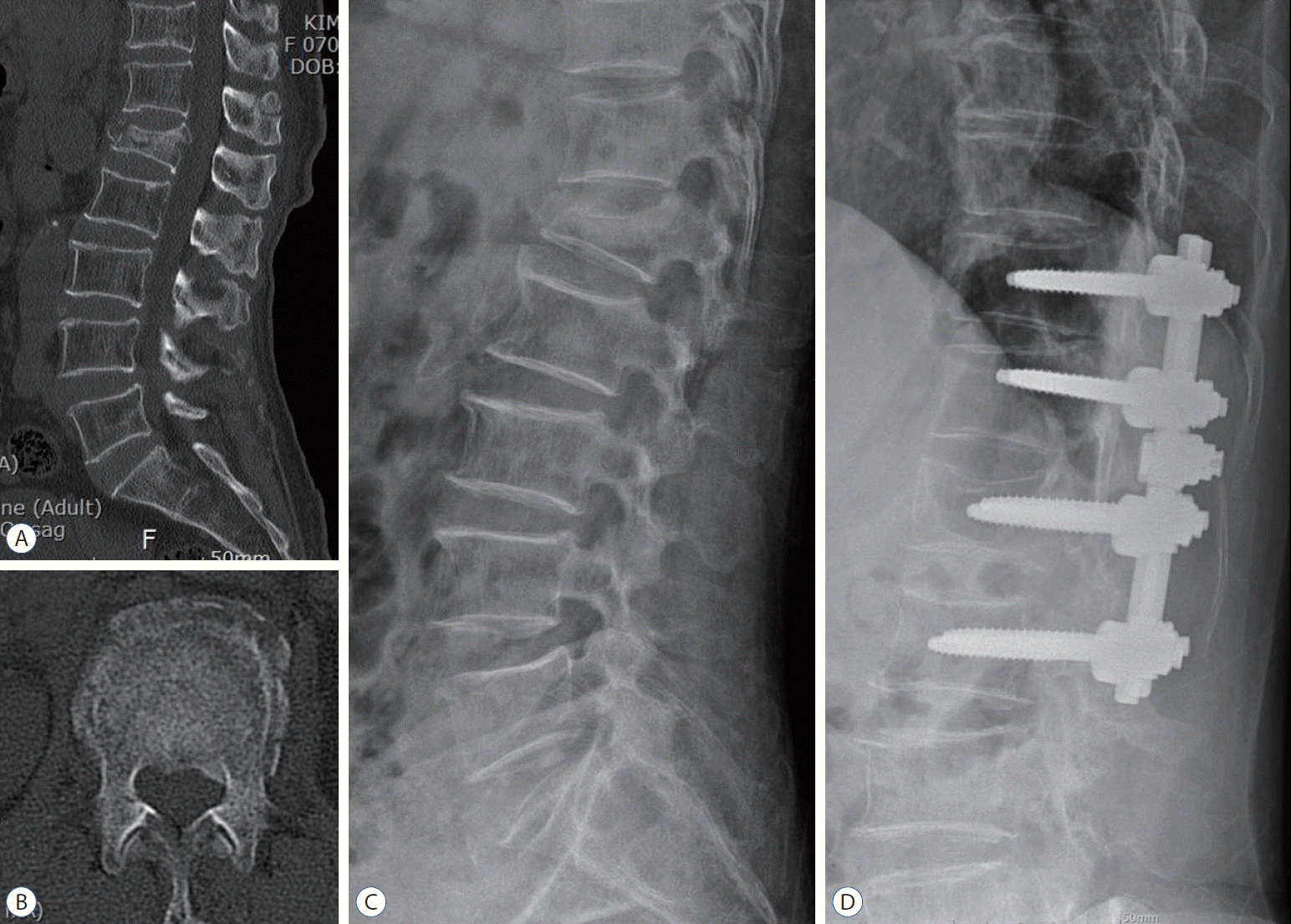1. Abe Y, Takahata M, Ito M, Irie K, Abumi K, Minami A. Enhancement of graft bone healing by intermittent administration of human parathyroid hormone (1-34) in a rat spinal arthrodesis model. Bone. 41:775–785. 2007.

2. Argoff CE. Pain management secrets. ed 4. Philadelphia: Elsevier;2018.
3. Aspenberg P, Genant HK, Johansson T, Nino AJ, See K, Krohn K, et al. Teriparatide for acceleration of fracture repair in humans: a prospective, randomized, double-blind study of 102 postmenopausal women with distal radial fractures. J Bone Miner Res. 25:404–414. 2010.

4. Been HD, Bouma GJ. Comparison of two types of surgery for thoracolumbar burst fractures: combined anterior and posterior stabilisation vs. posterior instrumentation only. Acta Neurochir (Wien). 141:349–357. 1999.

5. Canalis E, Giustina A, Bilezikian JP. Mechanisms of anabolic therapies for osteoporosis. N Engl J Med. 357:905–916. 2007.

6. Dobnig H, Turner RT. Evidence that intermittent treatment with parathyroid hormone increases bone formation in adult rats by activation of bone lining cells. Endocrinology. 136:3632–3638. 1995.

7. Ensrud KE, Crandall CJ. Osteoporosis. Ann Intern Med. 167:ITC17–ITC32. 2017.

8. Farcy JP, Weidenbaum M, Glassman SD. Sagittal index in management of thoracolumbar burst fractures. Spine (Phila Pa 1976). 15:958–965. 1990.

9. Inoue G, Ueno M, Nakazawa T, Imura T, Saito W, Uchida K, et al. Teriparatide increases the insertional torque of pedicle screws during fusion surgery in patients with postmenopausal osteoporosis. J Neurosurg Spine. 21:425–431. 2014.

10. Jacobs RR, Casey MP. Surgical management of thoracolumbar spinal injuries. General principles and controversial considerations. Clin Orthop Relat Res. 189:22–35. 1984.

11. Jilka RL, Weinstein RS, Bellido T, Roberson P, Parfitt AM, Manolagas SC. Increased bone formation by prevention of osteoblast apoptosis with parathyroid hormone. J Clin Invest. 104:439–446. 1999.

12. Kaliya-Perumal AK, Lu ML, Luo CA, Tsai TT, Lai PL, Chen LH, et al. Retrospective radiological outcome analysis following teriparatide use in elderly patients undergoing multilevel instrumented lumbar fusion surgery. Medicine (Baltimore). 96:e5996. 2017.

13. Kim JW, Park SW, Kim YB, Ko MJ. The effect of postoperative use of teriparatide reducing screw loosening in osteoporotic patients. J Korean Neurosurg Soc. 61:494–502. 2018.

14. Kim SJ, Park HS, Lee DW, Lee JW. Short-term daily teriparatide improve postoperative functional outcome and fracture healing in unstable intertrochanteric fractures. Injury. 50:1364–1370. 2019.

15. Lawrence JP, Ennis F, White AP, Magit D, Polzhofer G, Drespe I, et al. Effect of daily parathyroid hormone (1-34) on lumbar fusion in a rat model. Spine J. 6:385–390. 2006.

16. Liu Y, Levack AE, Marty E, Or O, Samuels BP, Redko M, et al. Anabolic agents: what is beyond osteoporosis? Osteoporos Int. 29:1009–1022. 2018.

17. Macnab I. Negative disc exploration. An analysis of the causes of nerve-root involvement in sixty-eight patients. J Bone Joint Surg Am. 53:891–903. 1971.
18. McCormack T, Karaikovic E, Gaines RW. The load sharing classification of spine fractures. Spine (Phila Pa 1976). 19:1741–1744. 1994.

19. Neer RM, Arnaud CD, Zanchetta JR, Prince R, Gaich GA, Reginster JY, et al. Effect of parathyroid hormone (1-34) on fractures and bone mineral density in postmenopausal women with osteoporosis. N Engl J Med. 344:1434–1441. 2001.

20. Nishitani K, Mietus Z, Beck CA, Ito H, Matsuda S, Awad HA, et al. High dose teriparatide (rPTH1-34) therapy increases callus volume and enhances radiographic healing at 8-weeks in a massive canine femoral allograft model. PLoS One. 12:e0185446. 2017.
21. Ohtori S, Orita S, Yamauchi K, Eguchi Y, Aoki Y, Nakamura J, et al. Does discontinuing teriparatide treatment and replacing it with bisphosphonate maintain the volume of the bone fusion mass after lumbar posterolateral fusion in women with postmenopausal osteoporosis? Asian Spine J. 11:272–277. 2017.

22. Oner FC, Verlaan JJ, Verbout AJ, Dhert WJ. Cement augmentation techniques in traumatic thoracolumbar spine fractures. Spine (Phila Pa 1976). 31(11 Suppl):S89–S104. 2006.

23. Ozsoy KM, Oktay K, Gezercan Y, Cetinalp NE, Okten AI, Erman T. Percutaneous vertebroplasty for the treatment of osteoporotic thoracolumbar fractures with posterior body involved in elderly patients. Turk Neurosurg. 29:90–94. 2019.

24. Park HJ, Lee SY, Park NH, Shin HG, Chung EC, Rho MH, et al. Modified Thoracolumbar Injury Classification and Severity Score (TLICS) and its clinical usefulness. Acta Radiol. 57:74–81. 2016.

25. Payer M. Unstable burst fractures of the thoraco-lumbar junction: treatment by posterior bisegmental correction/fixation and staged anterior corpectomy and titanium cage implantation. Acta Neurochir (Wien). 148:299–306. discussion 306. 2006.

26. Peichl P, Holzer LA, Maier R, Holzer G. Parathyroid hormone 1-84 accelerates fracture-healing in pubic bones of elderly osteoporotic women. J Bone Joint Surg Am. 93:1583–1587. 2011.

27. Qiu Z, Wei L, Liu J, Sochacki KR, Liu X, Bishop C, et al. Effect of intermittent PTH (1-34) on posterolateral spinal fusion with iliac crest bone graft in an ovariectomized rat model. Osteoporos Int. 24:2693–2700. 2013.

28. Rihn JA, Anderson DT, Harris E, Lawrence J, Jonsson H, Wilsey J, et al. A review of the TLICS system: a novel, user-friendly thoracolumbar trauma classification system. Acta Orthop. 79:461–466. 2008.

29. Saag KG, Shane E, Boonen S, Marín F, Donley DW, Taylor KA, et al. Teriparatide or alendronate in glucocorticoid-induced osteoporosis. N Engl J Med. 357:2028–2039. 2007.

30. Schnee CL, Ansell LV. Selection criteria and outcome of operative approaches for thoracolumbar burst fractures with and without neurological deficit. J Neurosurg. 86:48–55. 1997.

31. Shin JJ, Chin DK, Yoon YS. Percutaneous vertebroplasty for the treatment of osteoporotic burst fractures. Acta Neurochir (Wien). 151:141–148. 2009.

32. Shin WC, Moon NH, Jang JH, Seo HU, Suh KT. A retrospective bicenter comparative study of surgical outcomes of atypical femoral fracture: Potential effect of teriparatide on fracture healing and callus formation. Bone. 128:115033. 2019.

33. Sugiura T, Kashii M, Matsuo Y, Morimoto T, Honda H, Kaito T, et al. Intermittent administration of teriparatide enhances graft bone healing and accelerates spinal fusion in rats with glucocorticoid-induced osteoporosis. Spine J. 15:298–306. 2015.

34. Tseng YY, Su CH, Lui TN, Yeh YS, Yeh SH. Prospective comparison of the therapeutic effect of teriparatide with that of combined vertebroplasty with antiresorptive agents for the treatment of new-onset adjacent vertebral compression fracture after percutaneous vertebroplasty. Osteoporos Int. 23:1613–1622. 2012.

35. Umekawa M, Takai K, Taniguchi M. Complications of spine surgery in elderly Japanese patients: implications for future of world population aging. Neurospine. 16:780–788. 2019.

36. Vaccaro AR, Lehman RA Jr, Hurlbert RJ, Anderson PA, Harris M, Hedlund R, et al. A new classification of thoracolumbar injuries: the importance of injury morphology, the integrity of the posterior ligamentous complex, and neurologic status. Spine (Phila Pa 1976). 30:2325–2333. 2005.
37. Winkler EA, Yue JK, Birk H, Robinson CK, Manley GT, Dhall SS, et al. Perioperative morbidity and mortality after lumbar trauma in the elderly. Neurosurg Focus. 39:E2. 2015.

38. Zhang D, Potty A, Vyas P, Lane J. The role of recombinant PTH in human fracture healing: a systematic review. J Orthop Trauma. 28:57–62. 2014.
39. Zhang L, Wang T, Chang M, Kaiser C, Kim JD, Wu T, et al. Teriparatide treatment improves bone defect healing via anabolic effects on new bone formation and non-anabolic effects on inhibition of mast cells in a murine cranial window model. J Bone Miner Res. 32:1870–1883. 2017.









 PDF
PDF Citation
Citation Print
Print



 XML Download
XML Download